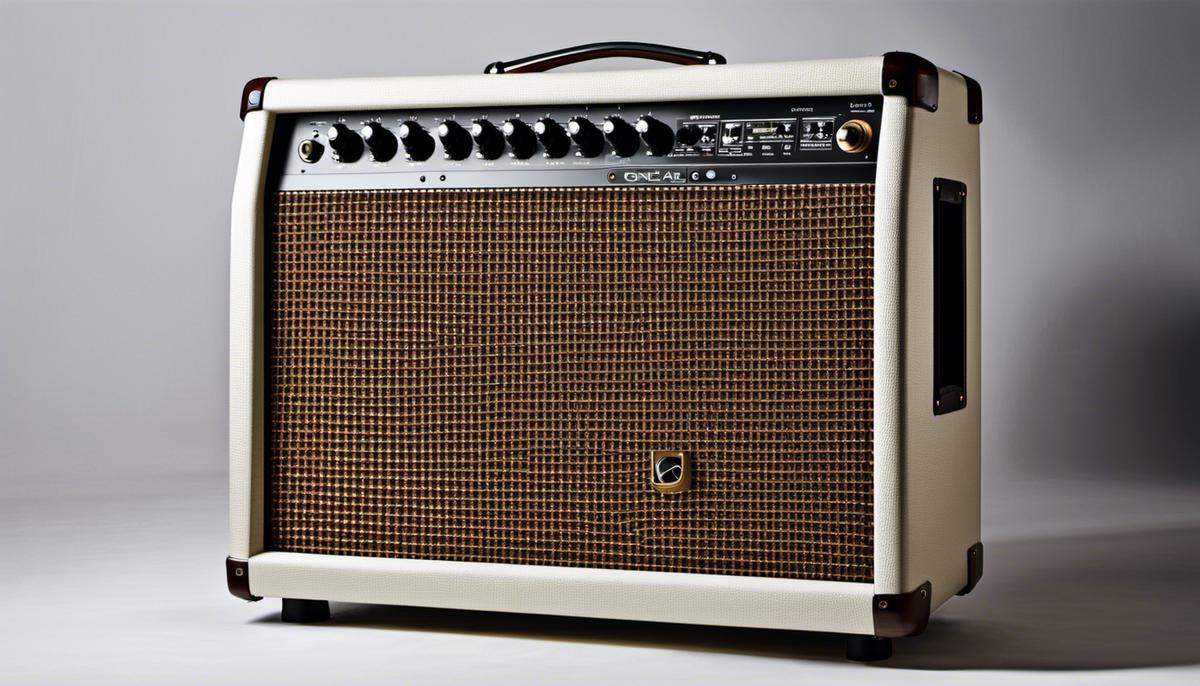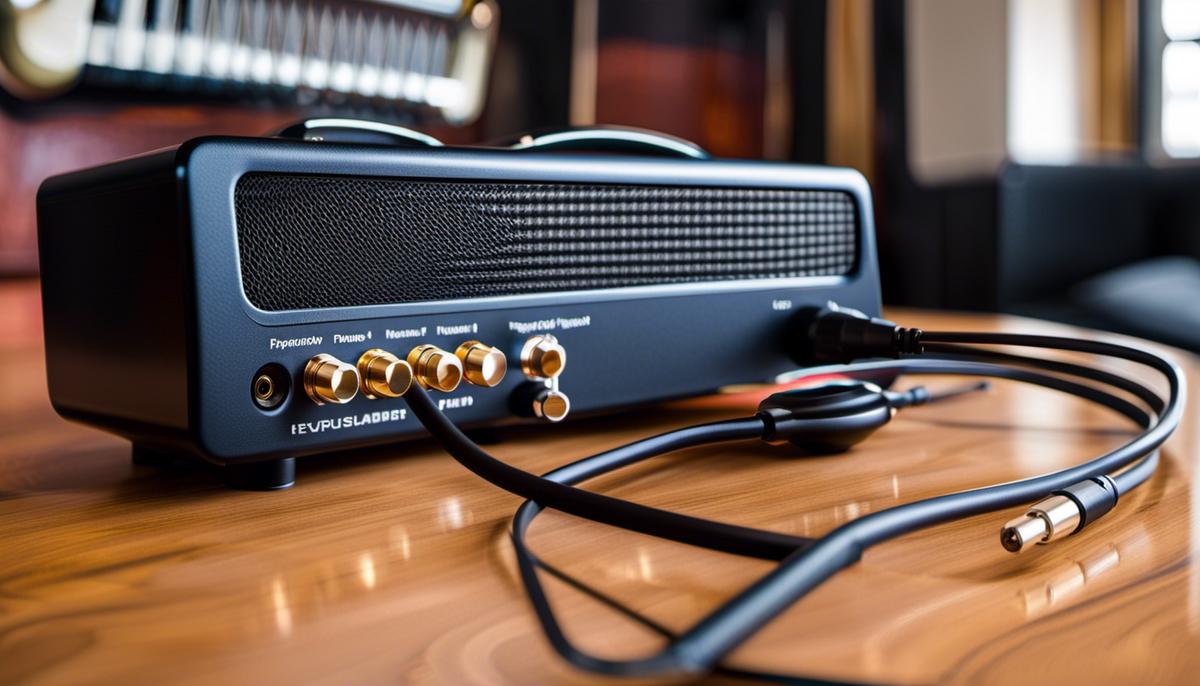
The vast and diverse world of music wouldn’t be as thrilling without the role played by guitar headphone amps. These nifty devices have rapidly become a must-have for every guitar enthusiast or professional. Whether you’re playing for an audience of one or hundreds, the right amp can dramatically enhance your experience, providing mind-blowing sound quality. Our guide promises to deliver a comprehensive understanding of guitar headphone amps, from their historical roots, practical functionalities, to various types suited for different users. We will also delve into factors to consider when buying an amp such as sound quality, portability, battery life, and so much more.
Understanding Guitar Headphone Amps
Understanding Guitar Headphone Amps
Guitar headphone amps are closely related to regular guitar amplifiers but have a distinctive function. They are portable devices that allow you to hear the output of your electric guitar through headphones. This is immensely valuable for those practicing individually, who not only do not want to disturb others, but also wish to hear their own performance in a clear, amplified manner. The standout features of such amps are their compact size and the provision of delivering high-quality sound directly to the ears of the guitarist.
Guitar headphone amps work by amplifying the low signal from your guitar to a level that can drive headphones. They boost the sound so you can hear it clearly and at a volume that suits your preference. These amps often come with additional features including tone control, volume control, and often even built-in effects like reverb, chorus, and distortion. Therefore, they also serve an important purpose in shaping and enhancing the tone of your guitar.
The importance of a guitar headphone amp cannot be overstated, especially for guitarists who practice routinely. They allow you to maintain the quality and clarity of your sound without the need for a full-sized amp. Since they deliver the sound directly into your headphones, they enable you to practice anywhere, anytime, without disturbing others.
Guitar headphone amps, just like any other guitar-related technology, have seen their evolution since the 1970s. Initially, they were mostly used in recording studios and professional setups. As technology advanced and the desire for personal sound control increased amongst musicians, guitar headphone amps became increasingly popular for personal use. The invention of pocket-sized designs made these devices even more accessible and practical for at-home practicing and on-the-go use.
Purchasing Guide for Guitar Headphone Amps
Key elements to keep in mind when purchasing a guitar headphone amp include sound quality, convenience, as well as battery longevity. Seek out an amp that provides a crisp, clean sound that remains unaltered and free of unnecessary noise. A lightweight and compact design prioritizes portability and is particularly useful for those expecting to transport their amp frequently. Also, consider the battery life as it can dictate the length of uninterrupted usage before recharging or battery replacement becomes necessary.
If you’re hoping to enhance or adjust your sound quality, look for models that offer built-in effects. However, keep in mind that the more features an amp provides, the higher its price tag. For those who simply require a basic amp for regular practice, economical and simpler models should suffice.
Examining the product for compatibility with your guitar and headphones is also important. Not all amps might accommodate every type of connector. To make an informed decision, considering user reviews and expert opinion can be extremely beneficial.
In conclusion, a quality headphone amp is a fundamental tool for any guitarist seeking unadulterated and private sound quality. From beginners and professional musicians to casual guitar enthusiasts, investing in an excellent headphone amp can enhance your overall playing experience and boost your skills by delivering top-tier feedback directly to your ears.

Factors to Consider when Buying a Guitar Headphone Amp
Exploring Sound Quality in Guitar Headphone Amps
Focusing on sound quality should be paramount when shopping for guitar headphone amps. Opt for amps that deliver rich, clear and distortion-free sound, even at high volumes. Amps with a broad frequency range and a favorable signal-to-noise ratio are preferable. Premium models often come with added perks like equalization controls or distinct sound effects, enabling further sound quality enhancement. Before purchasing, testing the amp or reading through online reviews can offer invaluable insights into the amp’s sound performance.
Portability of Guitar Headphone Amps
For musicians who are constantly on the go, the portability of a guitar headphone amp can be a crucial factor. Compact and lightweight designs are preferable as they are easy to carry around and do not take up too much space in your gear bag. Furthermore, a portable amp is perfect for practicing privately, irrespective of where you are. Portability, however, should not compromise the sound quality or power of the amp, which leads us to the next factor.
Guitar Headphone Amp Battery Life
The battery life of a guitar headphone amp is a key consideration, especially for those who play or practice for extended periods. An amp that requires frequent charging or battery replacements can be inconvenient and costly in the long run. Look for amps with long-lasting rechargeable batteries or amps that use energy-efficient technologies to extend battery life.
Guitar Headphone Amp Pricing
Cost is an important factor to consider when buying a guitar headphone amp. Whilst high-end models with superior sound quality and extra features may be appealing, they may not be necessary for everyone. Assess your budget and your requirements and aim for an amp that offers the best value for money. Keep in mind, though, that cheaper models might lack sound quality or durability.
Brand Reputation in the Guitar Headphone Amp World
When considering which amp to buy, the brand’s reputation can provide some insight into the product’s reliability and performance. Brands with a long history and positive reviews usually offer quality products and excellent customer service. Renowned brands such as Vox, Marshall, and Fender are renowned for their top-notch guitar headphone amps.
Construction and Quality of Guitar Headphone Amps
When buying a guitar headphone amp, one of the key aspects to consider is its build quality. A durable and hard-wearing amp with a solid casing and sturdy controls can withstand regular use and transportation. Furthermore, a well-constructed amp should also incorporate effective heat management to avoid overheating during use. The provision of a warranty and stellar customer service are also useful indicators of a manufacturer’s confidence in their product’s build quality.

Different Types of Guitar Headphone Amps
Understanding Plug-In Headphone Amps
Among the options for guitar headphone amps, plug-in versions are a common choice. Their direct plug-and-play design eliminates the need for cables, making them straightforward to use, just connect to your electric guitar, don your headphones, and you’re good to go. Many feature a variety of amp models and effects. For example, the Vox Amplug series offers distinct versions designed for different musical genres, emphasizing their adaptability. However, their small and lightweight design might mean they’re less sturdy compared to other amp types. Also, whilst their sound quality is generally said to be satisfactory, it may not equal the more sophisticated amp options.
Portable Pocket Amps
Portable pocket amps are the epitome of convenience. Often battery operated and compact, these amps can be used anywhere and offer a variety of sound options. Despite their small size, some models, such as the Line 6 Pocket POD, offer a wide array of amp and effect models, even allowing you to connect to your computer to customize your sound. However, like plug-in amps, they may have durability issues due to their compact design, and sound quality can vary significantly between models and brands. Because of their small footprint, the control interfaces on these amps can also be quite tricky to use, particularly for those with larger hands.
Stereo Amps
Stereo amps are typically more sophisticated and expensive than plug-in or portable pocket amps. They provide you with professional-level sound processing capabilities, often with a large array of built-in effects and amp models. Given their size, they are inherently less portable, but they tend to provide a higher level of sound quality and versatility. Models like the Vox VT20X offer a balance of portability and superior sound quality, and even include built-in tuners and metronomes. However, while stereo amps can offer the best audio quality, they are also generally more expensive and require a more substantial monetary investment.
Multi-Effects Units
Multi-effects units are the jack-of-all-trades in the guitar headphone amp world. They’re capable of providing a variety of amp models and effects, often allowing you to combine multiple effects for a truly personalized sound. Some models, such as the Boss GT-1, even provide advanced features like loopers and rhythm tracks, essentially offering an all-in-one practice solution. However, given their complex nature, there can be a steep learning curve with these units. Furthermore, while they excel at providing a variety of sounds, some players feel that individual sounds may not be as authentic or high-quality as stand-alone amps.
Digital Amps and Software Innovation
In this digital era, the popularity of digital amps and software like Guitar Rig or AmpliTube is skyrocketing for guitar enthusiasts. Vouched for their convenience and versatility, these programs abound with a vast spectrum of effects and amp models, providing you an unparalleled level of customization. However, it’s essential to bear in mind that these programs will often need the support of supplementary equipment such as audio interfaces. These could also present a learning curve if you’re getting into the swing of things technologically. It’s also worth noting that while digital amps do a commendable job, they might not utterly mirror the warm resonance and subtle nuances of their analog counterparts.

Top 5 Guitar Headphone Amps in the Market
Vox amPlug 2 AC30: A Top-Notch Headphone Amp
Ranking high among its peers is the superbly compact Vox amPlug 2 AC30 headphone amp that effortlessly mirrors the quintessential AC30 tone. With this versatile version, you’re granted access to three bespoke effects; chorus, delay, and reverb, resulting in a rich variety of audio character. A stand-out feature applauded by users is its auto power-off mechanism, attesting to this amp’s energy efficiency.
Pros: A compact build, an array of sound effects, and noteworthy energy efficiency.
Cons: It’s been observed that over time, its plug may become loose. The absence of a visual meter for gain and tone adjustment is another drawback.
BOSS Audio Waza-Air
Through use of wireless technology and a gyroscope sensor, BOSS Waza-Air offers a unique spatial experience, rendering the feel of playing in a physical room with a surround amp setup. Waza-Air offers 5 amp modes, onboard BOSS effects, and the convenience of choosing between stage and studio feel.
Pros: Innovative spatial technology, good selection of effects, wireless convenience.
Cons: Higher price point, dependence on batteries can be a drawback for frequent users.
Electro-Harmonix Headphone Amp
Electro-Harmonix is known robustly for its excellent pedals, but their pocket-sized Headphone Amp also stands out in the market. It delivers pristine clean tones and has an ultra low noise design to maintain sound quality. Besides, it includes a 1/4″ headphone jack adapter, making it versatility to different headphone sizes.
Pros: Compact and portable, low noise, versatile headphone compatibility.
Cons: No built-in effects or modulations, mono output not ideal for all headphones.
NUX Mighty Plug MP-2
This wireless marvel is widely celebrated for its versatility. The NUX Mighty Plug MP-2 offers a variety of amp simulations, effects, and it can connect to your phone via Bluetooth for added functionalities like music playback. This amp even has a noise reduction feature.
Pros: Versatility, wide range of sound effects, wireless and Bluetooth functions.
Cons: Users report that the app interface is not very user-friendly, latency in Bluetooth connection.
Line 6 Pocket POD
An intriguing mix of a headphone amp and portable multi-effects processor, the Line 6 Pocket POD offers an array of tonal options for guitarists. Equipped with over 300 presets, 32 amp models, and 16 cabinet models, this portable amp is known for its versatility and offers a broad spectrum of tone-shaping possibilities.
Pros: Wide range of amp models and presets, compact design, expansive tone-shaping options.
Cons: It might take some time to explore all the options provided due to its extensive features. Sound quality, though generally satisfactory, has been reported to sometimes have a digital tone.

How to Care and Maintain your Guitar Headphone Amp
Unraveling the Basics: Your Guitar Headphone Amp
Essentially, a guitar headphone amp amplifies your guitar’s sound for a personalized listening experience via headphones. These amps, often lightweight and portable, let you get lost in your music without disturbing those around you. To guarantee the longevity and high-quality sound from your device, it’s important to maintain it properly.
Cleaning Your Amp
Regularly cleaning your headphone amp is crucial for its longevity. Dust and debris can accumulate on your device over time and can interfere with its performance. Use a soft, dry microfiber cloth to wipe the exterior of the amp. Avoid using water or cleaning solutions as it could damage the electronic components. For the input and output jacks, consider using compressed air to dislodge any dust or particles.
Proper Storage
When not in use, store your guitar headphone amp in a cool, dry place. Avoid areas with high humidity or excessive heat, as these conditions can deteriorate the components of the amplifier. If you’re storing it for an extended period, remove the batteries to prevent potential leakage and corrosion. Consider investing in a protective case for added safety against accidental drops or scrapes.
Battery Care
If your headphone amp is battery-operated, proper battery management is essential. Always use the recommended batteries for your device and remove them if the amp is not going to be used for some time. Try not to overcharge your batteries as this can reduce their lifespan – It’s a good practice to unplug once the charging is complete. Take care not to expose the batteries to temperature extremes.
Cables and Connections
The conditions of cables and connections can significantly impact the overall performance of the headphone amp. Regularly check these for any signs of wear and tear. Replace frayed or damaged cables immediately. When plugging or unplugging your headphones, do so gently to avoid damaging the jack.
Avoid Overheating
While in use, make sure your headphone amp doesn’t overheat. Overheating can damage internal components and impair the amp function. If the amp gets too warm, turn it off and let it cool down before using it again. Therefore, avoid using it in hot conditions, near other hot devices or under direct sunlight.
Handle With Care
Although most guitar headphone amps are built to be sturdy, they should still be handled with care. Avoid dropping or knocking the amp against hard surfaces. Treat it as you would any other valuable electronic device.
Keep Volume Levels Safe
While we all love cranking up the volume sometimes, it’s important to remember that high volume level can damage both your hearing and the amplifier over time. Therefore, always keep the volume at a safe and reasonable level.
Keep these tips in mind to increase the life of your guitar headphone amp and allow it to give you the best performance possible.

Navigating the market for the perfect guitar headphone amp need not be a bewildering task. Armed with a comprehensive understanding of how these devices work, the characteristics of different types of amps, and the factors to consider when buying one, you’re more than equipped to make a worthy investment. Our guide doesn’t stop there – we also want you to get maximum longevity from your amp, and that’s why we’ve shared important tips on care and maintenance. Whether you are an amateur or a guitar connoisseur, this guide has been crafted to help you amplify your musical experience to new heights.
Comments are closed.